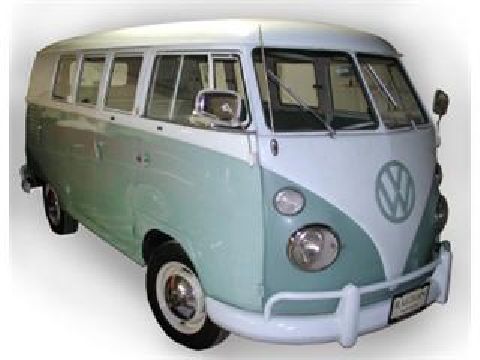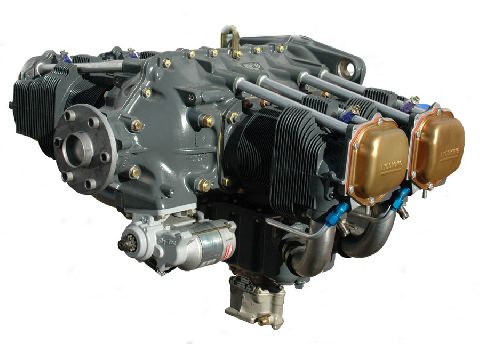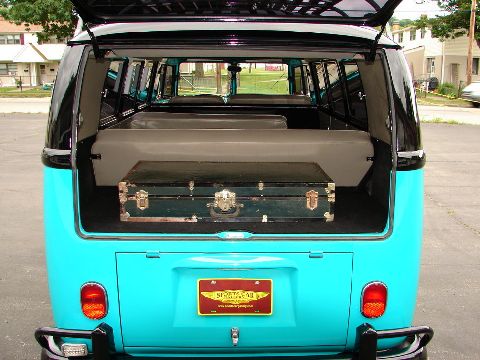Even Hitler Had One Good Idea
Soon after assuming power Adolf Hitler, knowing like many of our politicians today, how to curry favor with "the masses," ordered Frederick Porche to build a "Peoples Car." An affordable vehicle for those masses whose adulation he needed. It truly was a good idea. Porche, knowing where his bread would be buttered for the next several years, quickly came up with it. He called it a "Volkswagen." But most of "the masses" didn't get one. Their importance dropped off the chart when their "Glorious Leader" decided that Germany needed more "Lebensraum." But the idea of a "Peoples Car" didn't die and not too long after WWII ended, VW's, as they came to be called, were rolling out of the Porche factory. An increasing flood of them began to show up on American streets. But American families were growing larger after the war. They needed more room for kids than the little "Bug" or "Beetle" could accomodate. And that led to the birth of a different kind of VW. It was first called a "Transporter," then a "Microbus." We Americans, with our penchant for slang and shortening names, just called it a "bus."

An Early Version of the VW Bus
They evolved into fairly decent vehicles but by the time they reached that happy state the EPA had demonized both the "Bus" and the "Beetles" as polluters of their goddess “Mother Earth.” That, combined with the fact that “Detroit,” upon seeing how popular they were, began to produce larger and more powerful vans with more bells and whistles made the sighting of a Volkswagen Microbus on the road a cause for comment. Those you did see were usually bedecked with “Peace Symbols, “Flowers,” and other such “Hippie” identifiers, and were being used in ways quite different from what their designers had in mind, most of them questio
Our first VW bus was a used 1961 or `62 model. I soon discovered that the Germans of the mid-twentieth century saw such things as being comfortably warm in the winter and surviving a collision with anything larger than a dog as being minor features. All pre-2000 Volkswagens were powered by an air-cooled, 4 cylinder engine that was very similar to the engines found in most small private airplanes such as Cessna’s, Piper’s, etc. They also used the same system to provide heat to people in the van as is used in small airplanes. (As an aside, they don't work very well in small airplanes either.)


A Lycoming Aircraft Engine A Volkswagen Engine
Both of the engines are air-cooled. In an airplane the propeller and the oncoming wind keep the engine cool. The VW’s engines however were enclosed in a small compartment in the back end where there was no onrushing air. The Porche engineers (VW’s were made by the same company that builds Porches.) solved that problem by installing a big fan that forced air over the engine and down toward the ground. To keep people inside warm in the winter they put a lever on the instrument panel that, when pulled, would divert the hot air off the engine into the vehicle. It worked well for the cute little VW “Beetles.” But in the more spacious interior of their vans it was whistle in a hurricane. The inside temperature in a van on a cold day was as warm as it was going to get when those inside could no long see their breath.
During the time we had that VW bus I was taking night classes at Northern Illinois State University. Winters in Northern Illinois can be brutally cold, so when I left home on a winter’s eve for a night class I dressed as if I were going to run in the “Iditarod.” The drive to school in the twilight hours was bad enough but the 40 mile trip coming home late at night was an polar endurance run. Hat, warm coat, fur lined gloves and winter boots were the “uniform of the day.” I clearly remember pulling up to a stop sign one night, looking down and seeing a layer of ice under my feet. The trouble was that the engine, being just in front of the rear bumper, was too far from the heater vent near the driver’s feet. By the time hot air from the engine reached that far it was no warmer than a balmy breeze on a spring day.

Engine Compartment in a VW Bus
VW busses had another feature that would make today’s “consumer protectors” reach for the rule books or for a pencil with which to write a new rule. Tough-minded German engineers had given no consideration to protecting the driver and front seat passenger from anything other than the wind and rain. A lightweight bumper and one sheet of unreinforced sheet metal were the only obstacles between the driver and anything he saw through the windshield. I didn’t think about it much when I bought our first bus – later on it occurred to me that a collision with anything larger than a St. Bernard dog would be disastrous for me and anyone else in the front seat. After that epiphany I thought about it more often. But that didn’t stop me from trading that old bus in for a somewhat newer model and then several years later buying a brand-new 1972 model. Over all those years nothing had been done to improve the heat situation or front-end collision factor. The air-cooled engine was still located just in front of the rear bumper. The new one rode smoother and looked sexier, with nice bucket seats in front and a huge panoramic windshield.
We had the new bus when our youngest child was born - six years later than our fourth and what we thought would be our last one. When he (Nathan) came along his older brothers and sisters were old enough to sit in the middle and rear seats safely strapped in with seat belts. What to do with Nathan? My lovely wife discovered that a crib mattress fit perfectly in the cargo space between the back of the rear seat and the rear door. The floor of that space was also the “roof” over the engine and that became Nate’s traveling “home.” I referred to it as “The Nathan Hole” one day and the name stuck. “Where shall I put the groceries after shopping?” “Back in the Nathan hole,” was the answer. To this day any one of our kids would know immediately what I meant if I said “Nathan hole.”

The "Nathan Hole"
Today Nate is an airline pilot. He loved airplanes and flying from an early age and began learning to fly when he was 14 and soloed on his 16th birthday. He laughingly claims that all those months and miles he lay in “The Nathan Hole” with that little airplane-like 4-cylinder engine clattering and vibrating beneath him made his becoming a pilot inevitable. Could be. I know he locked into becoming a professional pilot long before he could drive a car.
As an aside, a few years later I bought a used 1972 “Super Beetle” and an older Chevy station wagon for a “family car.” The heating system that was so ineffective in the van worked beautifully in that little “Super Beetle.” The hot air outlets were right behind the driver and passenger seat, only a foot away from the engine. Those vents put out VERY hot air. Their efficiency led to an embarrassing, yet funny, incident. Not something I am proud of, but still humorous. In January 1975 I made another “career advancement move” which required us to move from Kansas City to Youngstown OH. It was a “hurry-up” move. I had to leave my family in KC for a few weeks while I looked for suitable housing in Youngstown. Once cold, January night I left KC with my Super Beetle jam-packed with enough clothing and personal stuff to last a few weeks. By nightfall I was somewhere in Illinois. I had the forced air heater in the Beetle on full blast. At that time in my life I was “overly attached” to alcohol (I was a practicing alcoholic.) so I made sure to pack a couple of 6 packs of beer on the floor just behind me. I was cruising along toasty and comfortable with the radio playing decent “driving” music when suddenly there was an explosive “WHOOSH” behind me. Before I had time to even wonder what had happened; beer fumes, vapor, and droplets of beer spewed out into the car and soaked into the upholstery. The canned beer I had placed directly in the “line of fire” of the heat vent had overheated and exploded. Cold January night or not I had to roll the windows down and drive that way until all the vapor and at least some of the smell had blown out into the Illinois night. At the next Interstate Rest Stop I dropped the exploded six pack, with appropriate alcoholic mourning for its loss, into the trash barrel. By the time I reached Youngstown OH most of the pool hall aroma had dissipated.
About the author
Comments 2
I love it!! I wish I could snip some of your classic metaphors and make a book of them. "surviving a collision with anything larger than a dog", "as if I were going to run in the “Iditarod.” Classic!!
Go for it, Tom. My mind is so cluttered with trivia that it just belches up imagery from time to time.




